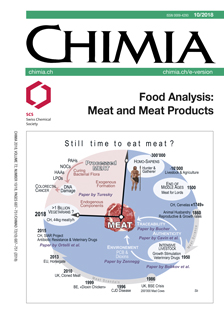Dioxins and PCBs in Meat – Still a Matter of Concern?
DOI:
https://doi.org/10.2533/chimia.2018.690PMID:
30376917Keywords:
Dioxins, Extensive farming, Food contamination, Polychlorinated biphenylsAbstract
Polychlorinated dibenzodioxins (PCDDs) and polychlorinated dibenzofurans (PCDFs) summarized as dioxins, as well as polychlorinated biphenyls (PCBs) are persistent, bio-accumulative and toxic environmental contaminants. Over 95% of human exposure to these problematic chemicals occurs via the ingestion of fatty rich food like meat and meat products, fatty fish, as well as milk and dairy products. Several major food and feed contamination incidents in Europe during the years 1997 and 2010 revealed the necessity of establishing food and feed monitoring programs for dioxins and PCBs. Various monitoring programs carried out by the Federal Office of Public Health (FOPH) and the Federal Food Safety and Veterinary Office (FSVO), suggest that cattle from extensive farming (suckler cow husbandry) exhibited higher levels of dioxin-like PCBs (dl-PCBs) and exceeded with higher frequency the permitted maximum levels (ML) when compared to conventional raised cattle. The reasons for the higher levels are possibly due to higher levels of PCBs in green fodder (pasture, silage, and hay) when compared to the concentrated feed used in conventional farming. Additionally, an increased uptake of soil, which is known to be a risk matrix for the uptake of dioxins and PCBs in grazing animals, leads to elevated contaminant levels in the suckler cows and hence their calves. Furthermore, PCB point sources present on a farm from older building and construction materials (e.g. PCB-containing wall paints) might result in very high contamination of the animals and the meat produced from them.Downloads
Published
2018-10-31
Issue
Section
Scientific Articles
License
Copyright (c) 2018 Swiss Chemical Society

This work is licensed under a Creative Commons Attribution-NonCommercial 4.0 International License.
How to Cite
[1]
M. Zennegg, Chimia 2018, 72, 690, DOI: 10.2533/chimia.2018.690.







